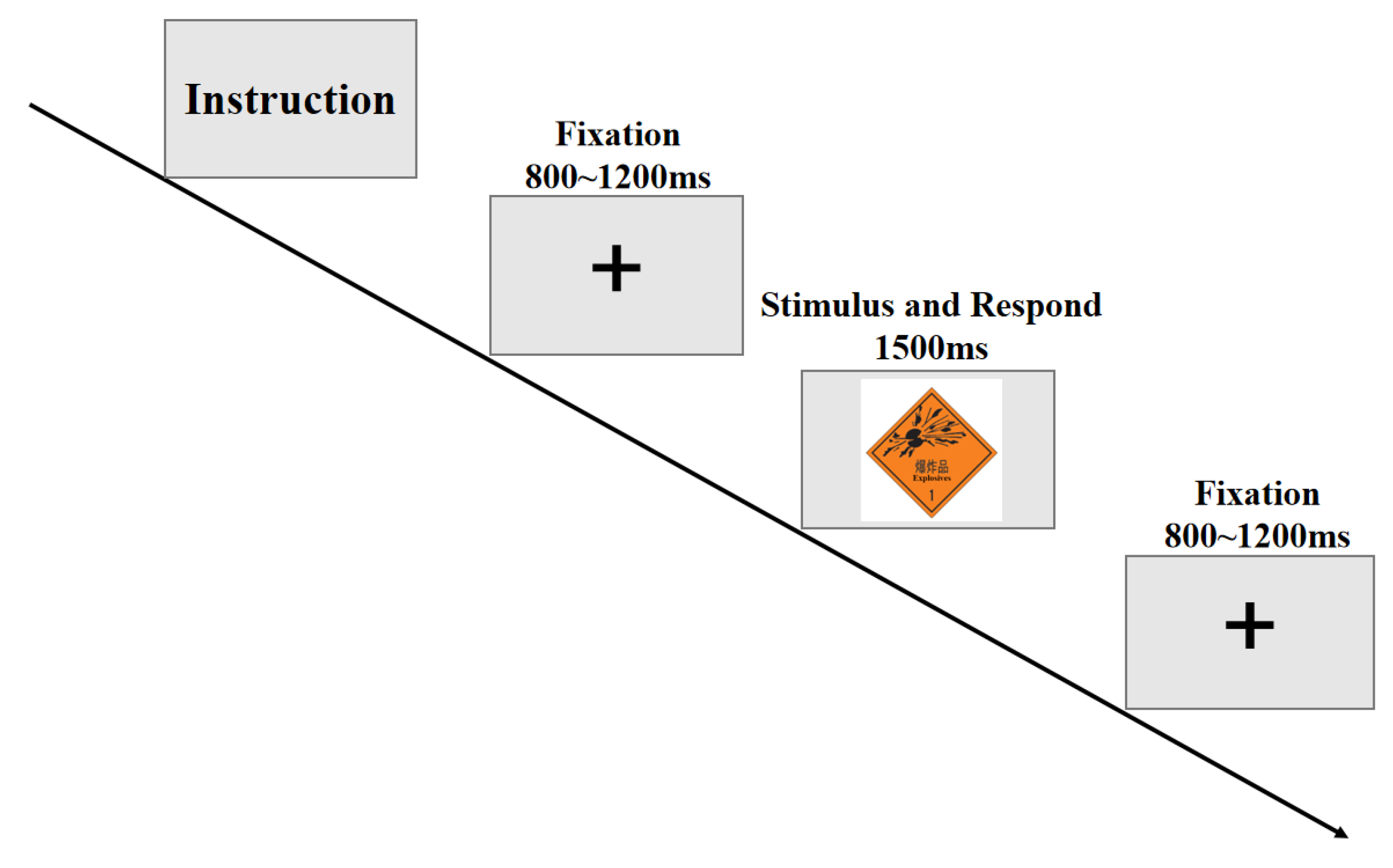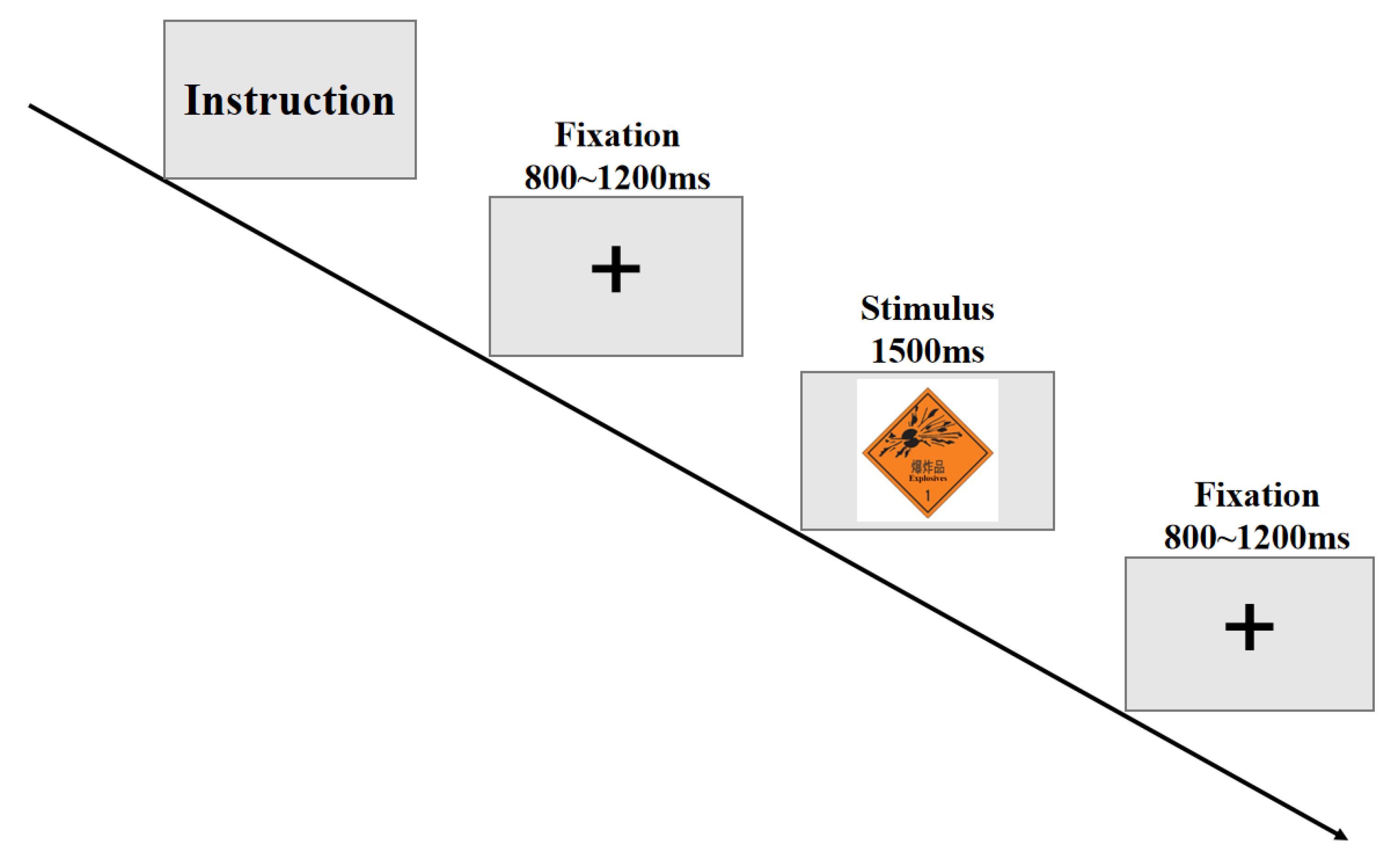Recognition Mechanism of Dangerous Goods Marks: Evidence from an Event-Related Potential Study
Abstract
1. Introduction
1.1. Electrophysiological Components of Risk Perception
1.2. Electrophysiological Components of Emotional Arousal
1.3. Study Objectives
2. Materials and Methods
2.1. Participants
2.2. Experimental Stimuli
2.3. Experimental Procedure
2.4. ERP Data Recording
2.5. ERP Data Analysis
3. Results
3.1. Behavioral Performance
3.2. ERP Results
4. Discussion
4.1. Dangerous Goods Marks Might Stimulate an Individual’s Risk Perception
4.2. Dangerous Goods Marks Elicit a Lower Degree of Emotional Arousal in Individuals
4.3. Differences Found in the Main Brain Sites in the Recognition Stage of Dangerous Goods Marks
5. Conclusions
Author Contributions
Funding
Institutional Review Board Statement
Informed Consent Statement
Data Availability Statement
Acknowledgments
Conflicts of Interest
References
- Liu, L.; Li, J.; Zhou, L.; Fan, T.; Li, S. Research on Route Optimization of Hazardous Materials Transportation Considering Risk Equity. Sustainability 2021, 13, 9427. [Google Scholar] [CrossRef]
- Akple, M.S.; Sogbe, E.; Atombo, C. Evaluation of Road Traffic Signs, Markings and Traffic Rules Compliance among Drivers’ in Ghana. Case Stud. Transp. Policy 2020, 8, 1295–1306. [Google Scholar] [CrossRef]
- Taamneh, M.; Alkheder, S. Traffic Sign Perception among Jordanian Drivers: An Evaluation Study. Transp. Policy 2018, 66, 17–29. [Google Scholar] [CrossRef]
- Kirmizioglu, E.; Tuydes-Yaman, H. Comprehensibility of Traffic Signs among Urban Drivers in Turkey. Accid. Anal. Prev. 2012, 45, 131–141. [Google Scholar] [CrossRef]
- Razzak, A.; Hasan, T. Motorist Understanding of Traffic Signs: A Study in Dhaka City. J. Civ. Eng. 2010, 38, 17–29. [Google Scholar]
- Laughery, K.R.; Wogalter, M.S. A Three-Stage Model Summarizes Product Warning and Environmental Sign Research. Saf. Sci. 2014, 61, 3–10. [Google Scholar] [CrossRef]
- Siswandari, Y.; Xiong, S. Eye Movements and Brain Oscillations to Symbolic Safety Signs with Different Comprehensibility. J. Physiol. Anthropol. 2015, 34, 42. [Google Scholar] [CrossRef]
- Hou, G.; Lu, G. Semantic Processing and Emotional Evaluation in the Traffic Sign Understanding Process: Evidence from an Event-Related Potential Study. Transp. Res. Part F Traffic Psychol. Behav. 2018, 59, 236–243. [Google Scholar] [CrossRef]
- Fu, H.; Niu, J.; Wu, Z.; Cheng, B.; Guo, X.; Zuo, J. Exploration of Public Stereotypes of Supply-and-Demand Characteristics of Recycled Water Infrastructure—Evidence from an Event-Related Potential Experiment in Xi’an, China. J. Environ. Manag. 2022, 322, 116103. [Google Scholar] [CrossRef]
- Cao, C.; Huang, Y.; Chen, A.; Xu, G.; Song, J. Improvement in Attention Processing After Surgical Treatment in Functional Pituitary Adenomas: Evidence from ERP Study. Front. Neurol. 2021, 12, 656255. [Google Scholar] [CrossRef]
- Kanunikov, I.E.; Pavlova, V.I. Event-Related Potentials to Faces Presented in an Emotional Context. Neurosci. Behav. Physiol. 2017, 47, 967–975. [Google Scholar] [CrossRef]
- Alzueta, E.; Melcón, M.; Poch, C.; Capilla, A. Is Your Own Face More than a Highly Familiar Face? Biol. Psychol. 2019, 142, 100–107. [Google Scholar] [CrossRef]
- Yuan, J.; Xu, S.; Yang, J.; Liu, Q.; Chen, A.; Zhu, L.; Chen, J.; Li, H. Pleasant Mood Intensifies Brain Processing of Cognitive Control: ERP Correlates. Biol. Psychol. 2011, 87, 17–24. [Google Scholar] [CrossRef]
- Schindler, S.; Kissler, J. Selective Visual Attention to Emotional Words: Early Parallel Frontal and Visual Activations Followed by Interactive Effects in Visual Cortex. Hum. Brain Mapp. 2016, 37, 3575–3587. [Google Scholar] [CrossRef]
- Jin, J.; Zhang, W.; Chen, M. How Consumers Are Affected by Product Descriptions in Online Shopping: Event-Related Potentials Evidence of the Attribute Framing Effect. Neurosci. Res. 2017, 125, 21–28. [Google Scholar] [CrossRef]
- Pratto, F.; John, O.P. Automatic Vigilance: The Attention-Grabbing Power of Negative Social Information. J. Personal. Soc. Psychol. 1991, 61, 3. [Google Scholar] [CrossRef]
- Correll, J.; Urland, G.R.; Ito, T.A. Event-Related Potentials and the Decision to Shoot: The Role of Threat Perception and Cognitive Control. J. Exp. Soc. Psychol. 2006, 42, 120–128. [Google Scholar] [CrossRef]
- Ma, Q.; Bai, X.; Pei, G.; Xu, Z. The Hazard Perception for the Surrounding Shape of Warning Signs: Evidence from an Event-Related Potentials Study. Front. Neurosci. 2018, 12, 824. [Google Scholar] [CrossRef]
- Shannon, R.W.; Patrick, C.J.; Venables, N.C.; He, S. ‘Faceness’ and Affectivity: Evidence for Genetic Contributions to Distinct Components of Electrocortical Response to Human Faces. NeuroImage 2013, 83, 609–615. [Google Scholar] [CrossRef]
- Zhu, L.; Zhou, H.; Wang, X.; Ma, X.; Liu, Q. Preference for Ugly Faces?—A Cognitive Study of Attentional and Memorial Biases toward Facial Information among Young Females with Facial Dissatisfaction. Front. Psychol. 2022, 13, 1024197. [Google Scholar] [CrossRef]
- Qin, J.; Han, S. Neurocognitive Mechanisms Underlying Identification of Environmental Risks. Neuropsychologia 2009, 47, 397–405. [Google Scholar] [CrossRef] [PubMed]
- Ma, Q.; Jin, J.; Wang, L. The Neural Process of Hazard Perception and Evaluation for Warning Signal Words: Evidence from Event-Related Potentials. Neurosci. Lett. 2010, 483, 206–210. [Google Scholar] [CrossRef] [PubMed]
- McPherson, W.B.; Holcomb, P.J. An Electrophysiological Investigation of Semantic Priming with Pictures of Real Objects. Psychophysiology 1999, 36, 53–65. [Google Scholar] [CrossRef]
- Yum, Y.N.; Holcomb, P.J.; Grainger, J. Words and Pictures: An Electrophysiological Investigation of Domain Specific Processing in Native Chinese and English Speakers. Neuropsychologia 2011, 49, 1910–1922. [Google Scholar] [CrossRef]
- Kumar, M.; Federmeier, K.D.; Beck, D.M. The N300: An Index for Predictive Coding of Complex Visual Objects and Scenes. Cereb. Cortex Commun. 2021, 2, 2. [Google Scholar] [CrossRef]
- Chen, L.; Cichy, R.M.; Kaiser, D. Semantic Scene-Object Consistency Modulates N300/400 EEG Components, but Does Not Automatically Facilitate Object Representations. Cereb. Cortex 2022, 32, 3553–3567. [Google Scholar] [CrossRef]
- Carretié, L.; Iglesias, J.; García, T.; Ballesteros, M. N300, P300 and the Emotional Processing of Visual Stimuli. Electroencephalogr. Clin. Neurophysiol. 1997, 103, 298–303. [Google Scholar] [CrossRef]
- Bian, J.; Fu, H.; Jin, J. Are We Sensitive to Different Types of Safety Signs? Evidence from ERPs. PRBM 2020, 13, 495–505. [Google Scholar] [CrossRef]
- Lu, G.; Hou, G. Effects of Semantic Congruence on Sign Identification: An ERP Study. Hum. Factors 2020, 62, 800–811. [Google Scholar] [CrossRef]
- Ma, Q.; Hu, L.; Xiao, C.; Bian, J.; Jin, J.; Wang, Q. Neural Correlates of Multimodal Metaphor Comprehension: Evidence from Event-Related Potentials and Time-Frequency Decompositions. Int. J. Psychophysiol. 2016, 109, 81–91. [Google Scholar] [CrossRef]
- Ito, T.A.; Cacioppo, J.T. Electrophysiological Evidence of Implicit and Explicit Categorization Processes. J. Exp. Soc. Psychol. 2000, 36, 660–676. [Google Scholar] [CrossRef]
- Eimer, M.; Holmes, A.; Mcglone, F.P. The Role of Spatial Attention in the Processing of Facial Expression: An ERP Study of Rapid Brain Responses to Six Basic Emotions. Cogn. Affect. Behav. Neurosci. 2003, 3, 97–110. [Google Scholar] [CrossRef] [PubMed]
- Li, P.F.; Lang, M.X. Hazardous Materials Transportation by Road: Fuzzy-Theory-Based Routing Design. AMM 2013, 397–400, 696–699. [Google Scholar] [CrossRef]
- Carretié, L.; Iglesias, J.; García, T. A Study on the Emotional Processing of Visual Stimuli through Event-Related Potentials. Brain Cogn. 1997, 34, 207–217. [Google Scholar] [CrossRef][Green Version]
- Larson, C.L.; Aronoff, J.; Steuer, E.L. Simple Geometric Shapes Are Implicitly Associated with Affective Value. Motiv. Emot. 2012, 36, 404–413. [Google Scholar] [CrossRef]
- Osorio, A.; Fay, S.; Pouthas, V.; Ballesteros, S. Ageing Affects Brain Activity in Highly Educated Older Adults: An ERP Study Using a Word-Stem Priming Task. Cortex 2010, 46, 522–534. [Google Scholar] [CrossRef]
- Maguire, M.J.; Magnon, G.; Ogiela, D.A.; Egbert, R.; Sides, L. The N300 ERP Component Reveals Developmental Changes in Object and Action Identification. Dev. Cogn. Neurosci. 2013, 5, 1–9. [Google Scholar] [CrossRef]
- Mazerolle, E.L.; D’Arcy, R.C.N.; Marchand, Y.; Bolster, R.B. ERP Assessment of Functional Status in the Temporal Lobe: Examining Spatiotemporal Correlates of Object Recognition. Int. J. Psychophysiol. 2007, 66, 81–92. [Google Scholar] [CrossRef]
- Zhu, L.; Ma, Q.; Bai, X.; Hu, L. Mechanisms behind Hazard Perception of Warning Signs: An EEG Study. Transp. Res. Part F Traffic Psychol. Behav. 2020, 69, 362–374. [Google Scholar] [CrossRef]





Disclaimer/Publisher’s Note: The statements, opinions and data contained in all publications are solely those of the individual author(s) and contributor(s) and not of MDPI and/or the editor(s). MDPI and/or the editor(s) disclaim responsibility for any injury to people or property resulting from any ideas, methods, instructions or products referred to in the content. |
© 2023 by the authors. Licensee MDPI, Basel, Switzerland. This article is an open access article distributed under the terms and conditions of the Creative Commons Attribution (CC BY) license (https://creativecommons.org/licenses/by/4.0/).
Share and Cite
Wei, Q.; Du, X.; Lin, Y.; Hou, G.; Liu, S.; Fang, H.; Jin, M. Recognition Mechanism of Dangerous Goods Marks: Evidence from an Event-Related Potential Study. Int. J. Environ. Res. Public Health 2023, 20, 5192. https://doi.org/10.3390/ijerph20065192
Wei Q, Du X, Lin Y, Hou G, Liu S, Fang H, Jin M. Recognition Mechanism of Dangerous Goods Marks: Evidence from an Event-Related Potential Study. International Journal of Environmental Research and Public Health. 2023; 20(6):5192. https://doi.org/10.3390/ijerph20065192
Chicago/Turabian StyleWei, Qiang, Xinyu Du, Yixin Lin, Guanhua Hou, Siyuan Liu, Hao Fang, and Ming Jin. 2023. "Recognition Mechanism of Dangerous Goods Marks: Evidence from an Event-Related Potential Study" International Journal of Environmental Research and Public Health 20, no. 6: 5192. https://doi.org/10.3390/ijerph20065192
APA StyleWei, Q., Du, X., Lin, Y., Hou, G., Liu, S., Fang, H., & Jin, M. (2023). Recognition Mechanism of Dangerous Goods Marks: Evidence from an Event-Related Potential Study. International Journal of Environmental Research and Public Health, 20(6), 5192. https://doi.org/10.3390/ijerph20065192





